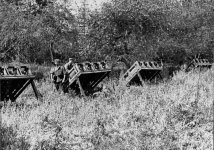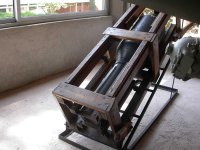bigwheelzip
Absent Comrade
There is a display of artillery pieces at the WWI battlefield of the Belleau Wood Marine Corps Memorial in France, that contained an interesting heavy trench mortar that I'd never seen before. I photographed all of the displayed pieces, and was just looking up the details on that mystery mortar. An historical photo I found of a mortar crew posing while loading the weapon, shed light on another unknown part of the display, the huge projectiles.
I thought the large projectiles displayed at the memorial came from a larger cannon than was being displayed there, but some of the historical photos showed those 200lb,10in diameter projectiles protruding past the end of the mortar tubes. So those big artillery shells on display were actually big mortar shells.
The low velocity of the round allowed for thinner walls and correspondingly more explosive, resulting in a greater destructive power than similar sized long range artillery. The muzzle photo shows the tube is rifled, so no stabilizer fins were needed for the projectile.



Sent from my SM-T510 using Tapatalk
I thought the large projectiles displayed at the memorial came from a larger cannon than was being displayed there, but some of the historical photos showed those 200lb,10in diameter projectiles protruding past the end of the mortar tubes. So those big artillery shells on display were actually big mortar shells.
The low velocity of the round allowed for thinner walls and correspondingly more explosive, resulting in a greater destructive power than similar sized long range artillery. The muzzle photo shows the tube is rifled, so no stabilizer fins were needed for the projectile.



Sent from my SM-T510 using Tapatalk
Last edited:






